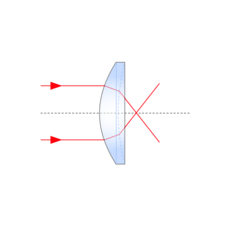For fiber lasers, high-power lasers, and UV lasers
Spherical lenses are optical components that are permeable to certain light spectra. At least one of the two optically active surfaces is curved. Single lenses are available with concave and convex radii and combinations thereof. Depending on the type of curvature – concave or convex – they focus a laser beam or widen it.
Lens systems, i.e. individual lenses combined to form lens groups, are used to correct the spherical aberrations that generally occur when spherical lenses are used. The areas of application for spherical lenses are diverse and range – depending on the material, curvature, and coating – from UV lasers to IR lasers.
Coated Spherical Lenses
LASER COMPONENTS has extensive manufacturing capabilities for coating spherical lenses of almost any shape – from plano-convex/concave to biconvex/concave to meniscus-shaped – with diameters from 6 mm to over 300 mm of the highest quality (typical for a Ø of 1”: 3/0.2, S&D 20-10) in various materials (BK7, quartz glass, and sapphire; other substrate materials are available upon request). The surface roughness is <0.5 nm RMS.
Anti-reflective (AR) coatings are applied to the optical surfaces to increase the performance of the optics through higher transmission and to reduce laser-induced risks due to reflections. All AR coatings used by LASER COMPONENTS are optimized for high-power lasers and are available for the wavelength range from 248 mm to 3000 mm. Both the bandwidth (depending on the wavelength) and the efficiency of the coating are influenced by different designs and different coating materials.
Many lenses are available from stock at low cost. Customized optics are our day-to-day business and can be manufactured in-house at short notice. We advise you in the selection of a suitable substrate, with regards to the lens shape/lens radius, and on a suitable AR coating.
Benefits
- Many radii and substrates available from stock
- Fast production, even for customer-specific requirements
- Attractive prices even for small quantities
- Highest quality “made in Germany”
Feature
- AR coatings for kW high-power lasers possible
Antireflective - AR - Coatings
Series
Spherical Lenses
Spherical Lenses - Best Form Lenses
Positive lenses with minimal spherical aberration.
When the highest demands are placed on the spot image

In best form lenses, the curvature ratio of the two spherical surfaces is selected to minimize spherical aberrations. These are clearly defined by the diameter of the incident beam and its wavelength. If these values are known, the radii of curvature of the lenses can be designed in such a way that they produce as little aberration as possible.
Best form lenses are always used when the highest demands are placed on the spot image.
Contact
Benefits
- The best spot image is applied when there is no room for multi-lens systems.
Spherical Lenses - Biconvex and Biconcave Lenses
For very short focal lengths with a large lens diameter at the same time
For low aberration
If large lens diameters are required for very short focal lengths that cannot be achieved with plano-concave/plano-convex lenses, then biconvex or biconcave lenses are used. These lenses have two curved surfaces.
The curvatures are often the same on both sides. In this case, they are also referred to as equi-concave/equi-convex lenses. However, there are also biconcave/biconvex lenses with different curvatures, such as, for example, best form lens.
As both sides of the lens are curved, the curvature of the individual sides is not as strong as in plano-concave/plano-convex lenses of the same focal length. The aberration is therefore lower, which is crucial for some applications.
Contact
Benefits
- Lower aberration for the precise focusing of the laser beam at short focal lengths
Antireflective - AR - Coatings
Spherical Lenses - Meniscus Lenses - Concave-Convex
Allow focus to small spot sizes.
To minimize aberration

A meniscus lens is an optical lens that consists of a concave and a convex side. Both sides have different and independent radii of curvature. They are divided into positive and negative meniscus lenses. The positive meniscus lens is more curved on the convex side than on the concave side. The opposite is true for the negative meniscus lens.
By introducing positive meniscus lenses into the beam path, it is possible to shorten the focal length and increase the numerical aperture (NA) without significant spherical aberrations occurring. Reducing the size of the laser spot while maintaining the same beam quality leads to a higher processing quality while simplifying the design at the same time. A negative meniscus lens increases the focal length.
Meniscus lenses are used in optical systems in which aberration must be minimized.
A negative meniscus lens increases the focal length, reduces the NA of the optical assembly, and widens the beam.
Contact
For focusing or widening the laser beam
Plano-convex and plano-concave lenses have a higher spherical aberration at the same focal length than lenses with two curved surfaces. In most laser applications, the aberrations are negligible due to the small beam diameter, making plano-convex and plano-concave lenses a cost-effective alternative with sufficient quality.
- Plano-convex lenses are positive lenses and have a positive focal length f; they focus the laser beam.
- Plano-concave lenses are so-called negative lenses and are used to widen the beam.
Contact
LASER COMPONENTS France - Your competent partner for optical and optoelectronic components in France.
Welcome to LASER COMPONENTS S.A.S., your expert for photonics components. Each product in our wide range of detectors, laser diodes, laser modules, optics, fiber optics, and more is worth every Euro (€/EUR). Our customized solutions cover all conceivable areas of application: from sensor technology to medical technology. You can reach us here:
45 Bis Route des Gardes
92190 Meudon
France
Phone: +33 (0) 139 595 225
Email: serviceclient(at)





